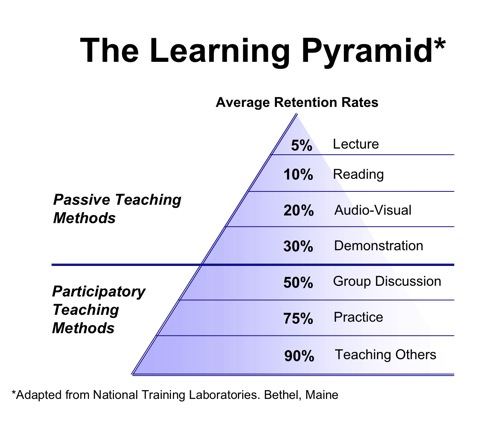Six Simple Steps to Create an Engaging In-service Training Program
/"That was a waste of time!" I have often muttered those or similar words to myself after sitting through a workshop. I walk in hoping that the workshop will be different from so many others, hoping that it will be engaging, informative, and practical. I usually emerge disappointed and frustrated.
That is the bad news. The worse news is that too often our teachers leave the training sessions WE conduct or arrange thinking or muttering the same thing--or worse.
After a few years of enduring fragmented training programs that are long on talk, short on practice, and with little accountability and follow-up, teachers soon learn to go through the motions of professional development. "This too shall pass" is the oft unspoken mantra. They make their appearance and then disappear with little evidence that the training changed anyone or anything. That is a waste of time, talent, and money.
It does not have to be this way. It should not be this way.
Professional development should be engaging and practical for teachers. It should also propel the school forward in achieving its core mission and strategic initiatives.
Here are six simple steps for creating an engaging and relevant professional development program.
Strategically Align Your Training Training programs should align staff values and skills with your school's strategic initiatives. For example, if one of your strategic initiatives is to enhance STEM instruction, then your in-service program needs to emphasize training in these areas. If one of your strategic initiatives is to strengthen student writing, then your in-service should focus on developing teachers' writing skills and their skills in teaching writing.
Surprisingly, aligning training with the school's strategic plan is rare. Usually, in-service training programs show little sustained connection with strategic objectives. As a result, training is disjointed with a different focus each year.

Take dead aim at your strategic objectives when planning your professional development program. Every tributary of training should flow into the strategic stream so that everything is moving in the same direction and mutually reinforcing. Your training should support your strategic plan and your strategic plan should inform your training plan.
Sustain Your Focus Old habits die hard. New skills require time and sustained practice to become new habits.
The best way to create positive change is to maintain sustained focus in your training. Focus on a few key concepts and skills over several years. Avoid the trap of annual de jour training. Serve up the same basic entree for several years but add courses to the training entree from year to year.
This one and half minute video beautifully illustrates the power of focus:
Apple WWDC 2013 Intro video dots.mov
Scaffold Your Training To maximize your ROI, professional development programs should be focused, sustained, and scaffolded.

For example, if your goal is to improve student writing, you could design a focused, multi-year, scaffolded training plan. For example:
- Year 1: Train teachers to improve their own writing skills. After all, you cannot teach well what you have not mastered.
- Year 2: Train teachers how to effectively teach writing.
- Year 3: Train teachers how to efficiently and effectively assess student writing.
- Year 4: Train teachers to help students use technology to produce and publish their writing to authentic audiences.
Clearly the training sequence above can be shortened. By combining training objectives, the above training can occur over two to three years. The point is that one week of in-service training will not produce significant improvement in the ability of teachers to teach writing, or any other skill. Unless training is sustained and scaffolded, there will be marginal impact on the quality of student writing.
This should not be a revelation. It takes years to teach students to write well. Why do we assume that we can teach teachers to become experts at teaching writing, or any other skill, in one week?
Less is More We try to cover too much. I have been guilty of packing too much training into the in-service week. While well intentioned, this is not effective. Like too many clothes stuffed into a suitcase, teachers come out of training feeling pressed and wrinkled, not crisp and sharp, ready for a new year.
An individual can only absorb so much. The central question to ask is; "what are the two or three specific behaviors I want teachers to demonstrate in the classroom from this point forward?" The answer to that question should determine the scope of training. Discard or delay everything else.
Do an excellent job on a few things rather than a mediocre one of on many. Do not seek to cover topics, seek to master two or three.
Hands-on Lectures play an important role in training but lectures seldom change professional practice. Consider the following diagram:

Reflect on the diagram for a movement. If the majority of your training is lecture-based then the majority of your training is lost, it is not affecting classroom practice.
Practice changes practice. There is a place for lecture, e.g., providing important background knowledge or explaining the rationale for the training but only hands-on-practice will change how teachers teach. Accordingly, the dominate form of training should the practice of new skills and concepts.
The best illustration I can give is technology training because we have all experienced bad technology training. The typical training involves a group assembled in front of a computer instructor. He or she demonstrates on the screen how to do "x." We watch, take notes, and perhaps fiddle with our computers. But, if we do not quickly start practicing what we have been taught we will forget. Remember, there is a difference between being taught and learning. Practice produces learning.
If, on the other hand, a short presentation of a technique is shown and ample time is provided for practicing the new skill, then we begin to understand and use it. The more time we have to practice the more likely we are to incorporate the skill into our work.
Here is a good rule of thumb; a ratio of 1:3 should be used for training. For each hour of training 15 minutes should be lecture or demonstration and the remaining 45 minutes for hands-on work. Doesn't this sound like good classroom teaching? If this is good classroom teaching it is good professional development.
Add Accountability
The adage, "what gets measured gets done" applies to teacher training. Because change is hard we need help and accountability. It is seldom enough to provide the rationale for change or even to practice new skills. If there is no consistent and transparent accountability for implementing new concepts and skills in the classroom there will be little change.
It is easy to make accountability a part of your professional development program. Revise your teacher evaluation instrument to include an assessment of the training provided. For example, if you provide training on techniques for teaching writing skills, add those techniques to the evaluation instrument so that they are assessed as part of the evaluation process.
Professional development can be effective and enjoyable. But is must not be ad hoc or an annual *de jour* experience. Good professional development is strategically aligned, is focused, sustained and scaffolded over several years. It is also hands-on with high levels of accountability for applying the training.
When these six elements of professional development are consistently practiced by school leaders, teachers are more likely to emerge from training declaring, "that was helpful, I can do that!"






 Guest Article by Mark Kennedy (ACSI Canada)
Guest Article by Mark Kennedy (ACSI Canada)

